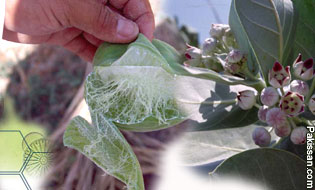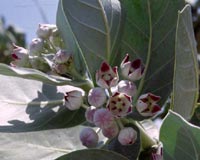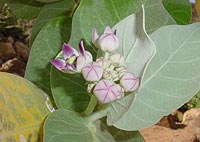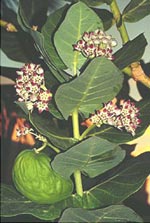|
Locust weed in riverine belt
By Shaukat Ali Bhambhro
Calotropis (Calotrops procera) is a common weed in Katcho area
(riverine belt) of District Khairpur. This weed plant, is
locally known as the Akh.
 It
belongs to the Asclepiadaceae family which includes 280 genera
and 2000 species of world wide distribution but most abundant
in the sub-tropics and tropics, and rare in cold countries. It
belongs to the Asclepiadaceae family which includes 280 genera
and 2000 species of world wide distribution but most abundant
in the sub-tropics and tropics, and rare in cold countries.
Calotropis yields a durable fibre useful for ropes, carpets,
fishing nets and sewing thread. It is also used as a medicinal
plant but here it is considered a useless weed.
However, a few Katcho area dwellers reported the use of floss,
obtained from the seed, for stuffing purposes. The poisonous
nature of this weed protects it from insect pests and animals.
It is a favourite food plant of a locust species locally known
as the Akh Makri (calotnopis locust). The calotropis locust is
not a true locust as it does not form swarms like that of the
desert locust, the African migratory locust, the red locust,
the Moroccan locust or the Italian locust.
 The
locusts exhibit swarming (mass migration of large bands),
whereas, the grashoppers do not, although they may multiply
rapidly and become pests of local importance. The
locusts exhibit swarming (mass migration of large bands),
whereas, the grashoppers do not, although they may multiply
rapidly and become pests of local importance.
Following the low rainfall in the riverine belt this year, a
rapid increase in the population of calotropis locust took
place and by mid July it was conspicuous and became the topic
of discussion among the Katcho area dwellers. A survey
undertaken by this scribe by the end of July indicated 20 to
50 locust (nymphs and adults) per bush of calotropis.
Calotropis weeds on hundreds of acre were almost completely
denuded, following vigorous feeding of its leaves. Later some
population of locusts were also observed from the denuded
calotripis plants to the cotton crop standing in the vicinity.
However, no damage to cotton crop was observed during the
survey.
In the subsequent survey, the locust population was found at
low ebb which may be due to the spraying of the cotton crop by
the pesticides. By the end of August these had completely
disappeared.
On inquiry it came to notice that the Akh locust became the
victim of predatory birds, especially the Rosy pastors locally
known as the "Wahyo" or tillear. According to the farmers of
the Katcho area, (Sadi bello, of District Khairpur) the swarms
of Wahy were seen attacking the locusts on bushes of
calotropis.
The attacks continued till the locust population subsided to
zero. The writer had to believe it because birds function as
an important natural check on the increase of insect
populations.
 The
destruction of locusts by birds continues not only when the
former are at the peak of their periodical abundance, but even
when their population is at a low ebb. The
destruction of locusts by birds continues not only when the
former are at the peak of their periodical abundance, but even
when their population is at a low ebb.
According to the Uvarov (1928), certain birds can play an
effective part in the suppression of an outbreak of locusts,
when it is already on decline. Hussain and Bhalla (1931)
listed 35 species of birds, belonging to 19 families,
attacking the locust in Punjab. Important species includes the
common Indian crow, the Rosy pastor, common Myna and the
northern grey partridge.
No doubt this July, the outbreak of calotropis locust was not
of the economic importance for an ordinary dweller as it
proved lethal for an unwanted weed plant.
The potential of the outbreak of this locust species could
have been harnessed using the increased population as a test
insect for locust control with the bio-pesticides by the
Locust Control Division of the Federal Plant Protection
Department, Karachi.
Whenever locusts invade, it is handled with the highly toxic
insecticides including the banned ones. Persistent use of it
may be lethal for the desert ecosystem as well as its
biodiversity.
No efforts have been made to monitor the healthier
environmental impact of locusticides used aerially or by
ground equipments during or after anti-locust campaign.
Since research carried out over many years has shown that the
Bio products based on spores of the entomopathogenic fungus
Metarhizium anisopliae var acridium (Maa) are very effective
against, and at the same time specific to locust, it is
warranted that the Federal Plant Protection Department,
responsible for controlling the desert locust, take the notice
of these development.
 Reportedly,
the Biological Control Product Ltd of South Africa now
produces the Green Muscle (GM) which demonstrated highly
successful field trials in many African countries. Reportedly,
the Biological Control Product Ltd of South Africa now
produces the Green Muscle (GM) which demonstrated highly
successful field trials in many African countries.
A similar product called the "Green Guard" (GG), which is
based on Maa, is being produced in Australia, where it has
been used successfully in controlling the indigenous locust
species. An FAO expert commission has attested to the
excellent efficacy and absolute harmlessness in environmental
terms of both the products.
The importance of locust control with bioinceoticides may be
viewed in the backdrop of the UN warning about locust plague
which may hit Pakistan and India in the months ahead.
According to the UN locust control officer swarms of locusts
sweeping through much of West Africa, may advance as far as
Saudi Arabia or even Pakistan and India, depending on whether
the creatures take root in Sudan.
Courtesy: The DAWN
|
Pakissan.com;
|